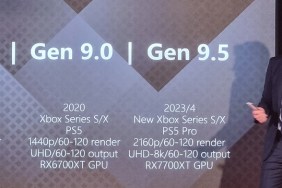Punch drunk love.
The Xbox 360 and the world of boxing have one thing in common: both are looking for a heavyweight contender. Boxing needs one badly now that Mike Tyson only kicks ass in Internet highlight videos, while the 360 lacks a champion to pit against Sony’s upcoming PS3. While Fight Night Round 3 may not answer all of Microsoft’s prayers, it throws a graphical haymaker you’ve got to see to believe.
No really, the only thing with better graphics than Round 3 is Scarlett Johansson, and that’s subjective. The fighters are photo-realistic, the venues are perfectly lit and even the crowds look good. And then there’s the
[image1]Aside from featuring the best graphics ever minus a heads-up display, the 360 version of Round 3 is identical to its current-gen counterparts, which in turn are mostly the same as last year’s Fight Night Round 2. In case you never got your mitts on Round 2, you use the left stick to move around the ring and the right stick to throw jabs, crosses, hooks and uppercuts. You can also throw haymakers by winding back on the analog stick, and then firing forward. These take more time than ordinary punches, but do heavy damage. Hit an opponent with a haymaker at the right time, and they’ll enter a vulnerable state in which one solid punch will put them on the canvas.
It gets newer. By pulling even farther back before swinging, you can execute a flash KO that will always put your opponent in a vulnerable state. Alternately, you can execute a stun punch that functions just like a flash KO, except the game shifts to a first-person view of the person in trouble, possibly disorienting them and giving you the opening to land another monster shot.
These new punches add an element of realistic danger to every fight, and they also place greater emphasis on the game’s weave and parry systems. By holding the L trigger or L1 button and rolling the L-stick, your fighter will stay put, bobbing and weaving under punches. You can’t duck everything, though, and this is where blocking comes into play. To protect yourself, simply hold the block button plus up or down on the right stick. You can parry by blocking in the direction of an incoming punch, leaving your opponent open for a brutal counter.
Unfortunately, the parry system is a little broken. Instead of only blocking shots from a certain angle – say, high right “ holding either high parry will essentially block all high punches. It negates the element of risk and makes parrying a bit too powerful and easy.
This is a small gripe, though, and doesn’t undercut the fact that Round 3 is absurdly fun to play. This is most apparent when boxing a friend in a Vs. match or an anonymous enemy online. The tale of the tape for these modes is basic in terms of options and trimmings. You can engage in normal battles, Hard Hits bouts (knockdowns end the round) and ESPN Classics online and off, but none of this communicates just how interesting it is to observe an opponent’s pattern of attack, counter and deliver a crushing blow.
Round 3 is really meant to be played against other people. The control scheme is simple enough for anyone to pick up quickly, deep enough to keep them playing for hours, and powerful enough to make victory ecstatic and defeat crushing. It’s just tons of fun.
[image2]The single-player options don’t pack nearly as much punch, however. Predictable A.I. and an extremely wimpy Career mode keep Round 3 from kicking ass in every arena. When you begin a career, you can either create a fighter or attempt to take an existing champ from the bottom of the boxing world to the top. Since your career plays out the identically whether you choose an existing champ or make a new one, you might as well just create a new boxer.
This is handled via the game’s sophisticated character creation system. Using sliders to tune everything from your fighter’s body type to the shape of his nose, you can spend hours tweaking his appearance, making him a pin-headed behemoth, a sharp-featured assassin or anything in between. That is, except a one-eyed, three-armed anatomical freak. While the customization options are deep, they don’t allow you to venture into any bizarre waters, which is a shame considering the way such a fighter would contrast with the game’s otherwise extremely realistic graphics.
Once your disappointingly human pugilist is ready, you’ll jump right into his career. This involves picking someone to fight, picking a trainer, training, fighting and doing the whole thing over again until you get sick of your job and retire. Picking an opponent is called “Signing a contract,” but that suggests an illusory level of depth and realism. There’re no negotiations or crazy-haired promoters, you simply decide who you want to face and fight them.
Next you pick a trainer, of which there are three: one is free of charge, one costs quite a bit, and the last is expensive. What’s silly is the fact that paying a trainer’s fee only buys him for one bout. Then again, the only noticeable difference between trainers is the amount their cut-men heal you between rounds. If you don’t plan on taking a beating, one is as good as another, especially due to the fact that all their training regimens are identical. Before a fight you can work the heavy bag, the combo dummy, or lift weights. Each exercise is an extremely simple mini-game and buffs up a few of your attributes, while slightly diminishing the rest. This system is identical to the one found in Round 2 and could have used a little bulking up itself.
Eventually you’ll step into the ring. If you win, you’ll gain popularity in your, ugh, popularity meter, and when that fills, you get a shot at a title belt. In the previous game, you actually got a ranking and worked your way up to the number one spot. This was very basic, but at least realistic. The popularity system doesn’t seem to have anything to do with real boxing and makes career mode feel like a meaningless string of fights.
Due to a rather large hole in the A.I., normal and title fights are equally easy to win. Computer opponents are ubiquitously bad about protecting their abdomens, and can generally be dispatched with several hard body shots. Once you figure this out, you may as well throw in the towel, because your career as a fighter will never be interesting again.
The only thing left to do is build up tons of cash and spend it at the fight store, where you can buy new shorts, mouth pieces, gloves and other fighter accoutrements, some of which will significantly enhance your attributes. But since the A.I. is so weak, it hardly matters.
The other single-player modes are equally glass-jawed. ESPN Classics mode lets you relive famous fights, but other than being presented in gray-scale, they’re just like any of the ‘Play Now’ bouts. In an absurd twist of inaccuracy, these old-time fights feature brand new ads for, say, Dodge or Burger King, which plague pretty much every mode in the game. This review is brought to you by Doritos, by the way.
[image3]To match the thin single-player content, Round 3 features a pretty trim cast of fighters. Several unexpected greats make the cut, such as Roberto Duran and Manny Pacquiao, but there are equally conspicuous omissions and several of the fighters appear in dual weight classes. Do Roy Jones Jr. and James Tony really need to be included as light heavyweights and heavyweights, when the game entirely omits George Forman, Mike Tyson and Lennox Lewis? At least the game perfectly captures the styles and idiosyncrasies of its select few. Roy Jones’ insane flurries are as frighteningly fast as ever, Pacquiao looks just as wild and expertly out of control in the game as he does on TV, and Muhammad Ali floats like a butterfly and, occasionally, stings like a bee.
Not only do the boxers feel convincing, their clashes look and sound great. The Xbox version is remarkably realistic looking and fluid, with fighters becoming visibly disfigured as fights wear on and more big punches land. When a fighter is caught with a punch that sends them into a vulnerable state, the action slows down and the edges of the screen blur. If a big punch lands you’re treated to a slow-motion replay of the impact, complete with spittle and blood spraying from the damaged fighter’s mouth. Talk about a money shot. Both the PS2 and Xbox versions move at the same unflinching pace, though the PS2 does so without as many frames of animation or textures. This is important in a game where gauging your opponent’s animations is key, making the Xbox version slightly better.
But that’s only half the story. The sound effects are unbelievable in both versions, conveying a sense of impact completely unique to Round 3. Staggering punches don’t just look painful, they sound painful. Incidentally, painful is also a good word to describe the commentary, which is inaccurate and repetitive, and the soundtrack, which is a bad assortment of overproduced hip-hop tracks.
Fight Night Round 3 may not have a spotless career, but with such hard hitting graphics and intense Vs. action, we’re willing to forgive its foibles and trumpet its unparalleled successes. If you bought an Xbox 360, this game is why. Show your friends, taunt your nephews, ignore your girlfriend – this game has the heart of a champion and is pound for pound the best 360 game around.
-
OMFGraphics
-
Powerfully violent
-
Excellent controls
-
Dangerous new punches
-
Boring, revised Career mode
-
AI issues
-
Overpowered parries







